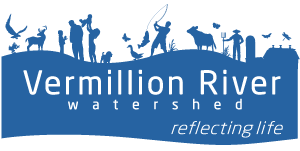Frequently Asked Questions
Of all the government agencies, watershed organizations tend to slip under the radar. You might not see them very much outside of your property taxes. But healthy watersheds are vital to a healthy environment – and the Vermillion River Watershed is no exception. Here are some frequently asked questions we hear from some folks:
A. A watershed is the area of land that drains to a river, lake, or other waterbody. If a raindrop falls anywhere inside the watershed, it will eventually find its way to the main waterbody. We all live in a watershed.
A. The Vermillion River Watershed is the largest watershed in the Minneapolis-St. Paul seven-county metropolitan area. The watershed drains 335 square miles in Dakota, Goodhue, and Scott counties.
The river’s headwaters emerge in New Market Township, Scott County. The Vermillion River main stem travels 35 miles west to east, joined by four major tributaries (North Creek, Middle Creek, South Creek, and South Branch) and many unnamed minor tributaries. The watershed includes 49 miles of Minnesota Department of Natural Resources-designated trout streams. The river meets the Mississippi River near Red Wing.
The watershed encompasses farmland, suburban developments, industrial zones, parks, open spaces, cities, and townships, including Apple Valley, Burnsville, Castle Rock Township, Coates, Douglas Township, Elko New Market, Empire, Eureka Township, Farmington, Hampton, Hampton Township, Hastings, Lakeville, Marshan Township, New Market Township, Nininger Township, Ravenna Township, Rosemount, Vermillion, and Vermillion Township.
A. Maybe! Type your address into this map and see if it falls within our boundaries.
A. Watershed organizations are local government units responsible for protecting, managing, and improving the water resources of their areas. In Minnesota, we have watershed districts (WDs) and watershed management organizations (WMOs). WMOs specifically exist in the Twin Cities Metro Area and are often joint-powers organizations between cities or counties. Dakota and Scott counties signed a joint powers agreement in 2002 to form the VRWJPO (as a WMO) and manage the watershed as required by Minnesota Statutes 103B and Minnesota Rules 8410.
The VRWJPO’s work is set by its Watershed Management Plan, which must be updated every ten years. The Plan is developed through an inclusive public engagement process, reviewing water monitoring results, and research on changes in local demographics and land use. The JPO also puts in place some rules and policies in cooperation with local governments. Read more on that here.
Day-to-day, VRWJPO staff spend their time planning water resource improvement projects, meeting with partners, or doing community outreach on water stewardship.
A. Many different organizations are responsible for protecting water. Who should you contact for permits, technical assistance, funding, or training?
Groundwater – The water held underground in the soil or pores and crevices in rock. Groundwater supplies drinking water, irrigation, and business uses, either through municipal suppliers or private wells. The majority of water users in Minnesota rely on groundwater. During droughts, groundwater helps maintain lake levels, wetlands, and stream flow. Often, people who use groundwater have water softeners in their buildings to remove excess minerals. And, check out this video from Dakota County about our everyday connections to groundwater.
Surface Water – Water that collects on the surface of the planet, such as in a river, lake, or wetland. Lakes collect water, but do not (usually) change location or boundaries. Rivers collect and convey water, so they may shift location and boundaries as they move through the landscape. Some areas rely on surface water for drinking or business use. Fish and wildlife conditions can tell us interesting things about the health of a surface water ecosystem.
Stormwater – Stormwater comes from rainfall, snowmelt, and ice melt. Stormwater can infiltrate into the soil, be held on the surface and evaporate, or run off and end up, through storm drains, in nearby streams or rivers without any treatment. As stormwater runs off different surfaces, it can collect pollutants and carry them to waterways, leading to algae blooms and dangerous contamination.
Shorelands & Floodplains – Shoreland is the land along a river or lake. A floodplain is an area of low-lying ground adjacent to a river, formed mainly of river sediments and subject to flooding. Shoreland that erodes because a river is too high or moving too quickly can lead to flooding in surrounding areas. Structures located in floodplains can get flooded and carried into a river, causing pollution and damage downstream.
Wastewater – Wastewater is water that has been used for washing clothes, flushing a toilet, or in a manufacturing process and contains waste products like sewage. Wastewater, unlike stormwater, must be treated before it is released to a nearby water body. Facilities allowed to discharge treated wastewater must have a permit that sets standards for water quality. In the Twin Cities Metropolitan Area, wastewater is piped to a Metropolitan Council Environmental Services treatment plant for pollutant removal. In rural areas, residential septic systems treat wastewater to remove pollutants.
Agriculture – Agriculture is the practice of growing crops and rearing livestock to provide food, feed, fuel, and fiber. Precipitation and irrigation are essential for farmers, as is using fertilizer or animal manure to enrich the soil for ideal crop production. These can have serious impacts on water quality and quantity if not managed well.
More resources:
Minnesota Department of Health Well Owner’s Handbook
Minnesota Pollution Control Agency Water Resources
Dakota County Geographic Information Services
Minnesota Agricultural Water Quality Certification Program
University of Minnesota Extension Water Resources
MN Board of Water and Soil Resources
Metropolitan Council Environmental Services
Minnesota Department of Health Water Information
Mississippi National River and Recreation Area
Scott Soil and Water Conservation District
U.S. Environmental Protection Agency
U.S. Department of Agriculture
Dakota County Soil and Water Conservation District
Natural Resources Conservation Service
If you find an error anywhere in this list, please email brita.moore-kutz@co.dakota.mn.us and we’ll update. Check out this article from Freshwater for some history on water governance in Minnesota.


